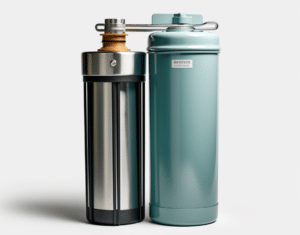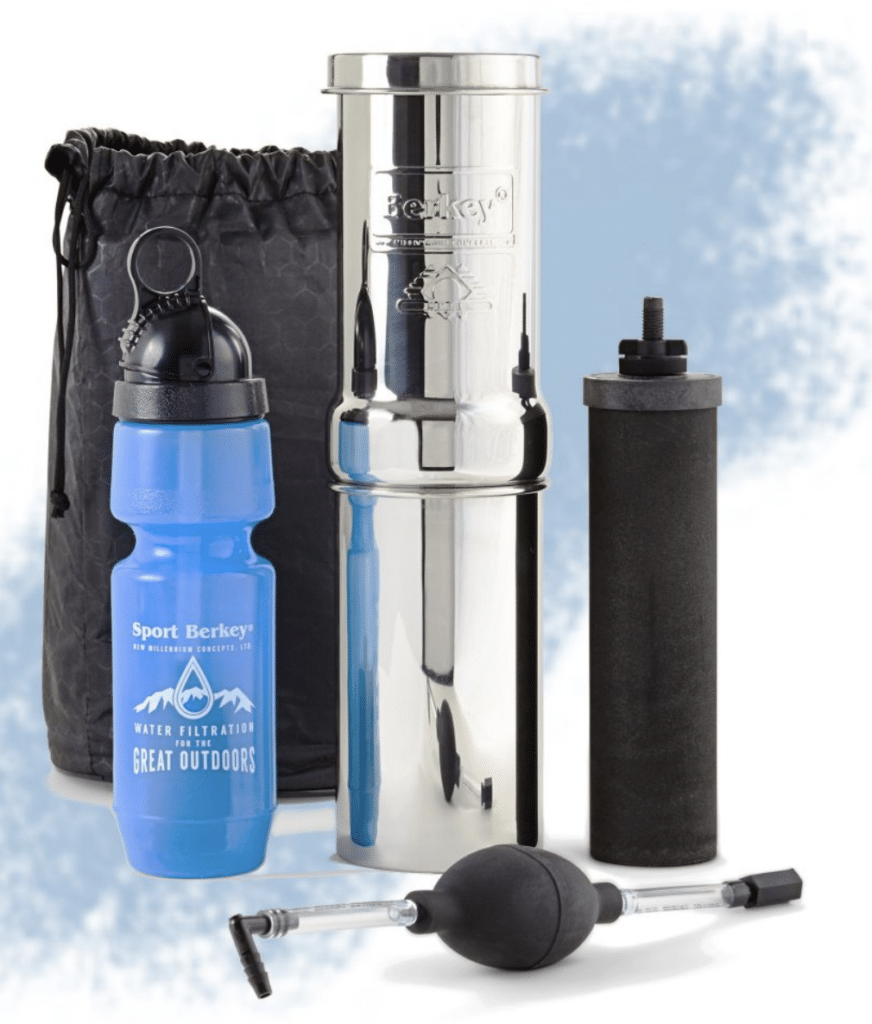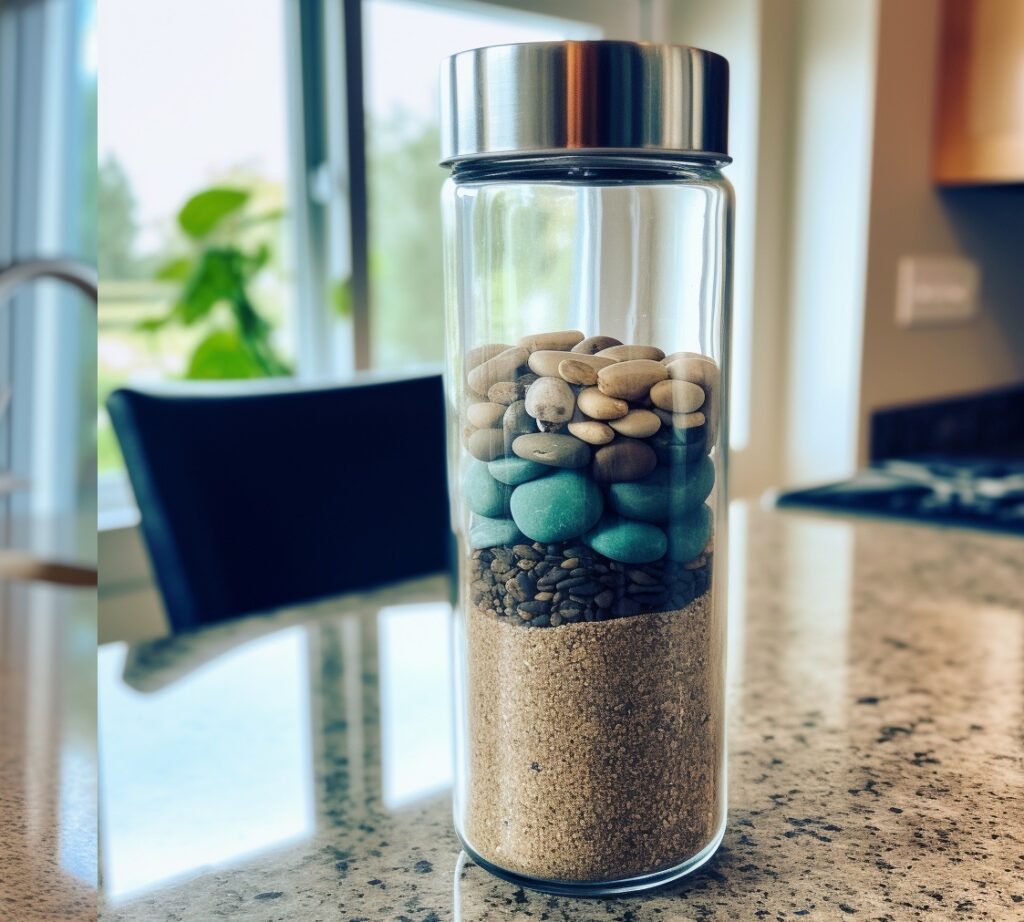Introduction – Eco-Friendly Water Filters
Access to clean, filtered water is essential for maintaining good health and protecting the environment. As discussions around sustainability and eco-friendly living continue to gain traction, more of us are seek options that prioritize both health and environmental responsibility.
This article will provide an overview of various environmentally-friendly water filter options, highlight the benefits of choosing eco-friendly, plastic-free water filters, and explore how these choices contribute to sustainable living as a whole.

We present our top 4 commercial choices for eco-friendly non-plastic water filters. After that we will talk about what criteria we used and then, more as an educational exercise, how a filter works by making one.
Although we’ve made an effort to present only plastic-free filters, the reality is that there are little bits and pieces of plastic parts in most products. What we find here however, is the best effort to reduce the plastic content.
There are also entire classes of materials that substitute for plastics – one in particular is silicone which have desireable longevity properties and are worth investigating as parts of a water filter.
Top Eco-Friendly and 3 Plastic-Free Water Filter Brands
1. Berkey Filters

The Go Berkey Kit with Black Berkey Primer is a highly efficient and eco-friendly water filtration system designed for versatility and reliability.
Its durable and polished 304 stainless steel construction holds a capacity of 1 quart, making it ideal for various situations, from emergency kits to outdoor adventures or daily use.
The kit’s standout feature is the Black Berkey® filtration element, capable of purifying over 1.5 gallons per hour and effectively removing heavy metals, pharmaceutical drugs, bacteria, rust, sediment, foul tastes, and odors, going beyond lab detection limits.
With easy setup and the included Berkey® Quick-Start Kit, installation is a breeze, while the lifetime warranty from USA Berkey Filters™ adds extra reassurance for long-term usage.
2. AquaOx Whole House Water Filters

The AquaOx Water Filter is a premium product designed to deliver clean, high-quality water to households. With a capacity of over 2,000,000 gallons, it’s rated for up to four bathrooms and can output up to 15 gallons per minute (gpm).
The product is designed for easy installation and promises to provide better-than-bottled water from every tap in the home. Its lifespan is considerable, with the ability to deliver great tasting water for 20 or more years. Priced between $3,499.00 and $4,999.00, it can be financed for as low as $122 per month through Affirm.
The AquaOx incorporates a complex filtration system combining catalytic carbon media, KDF, coconut shell carbon, garnet, and Filter AG. This combination allows for superior water filtration and purification.
The system also features an automatic backwashing head. Other specifications include a weight of 115 lbs, dimensions of 10 × 10 × 62 inches, a maximum service flow of 15 gpm, and a regular 110 outlet for its digital power head.
The device accepts an inlet/outlet connection of 1″ male threaded and has a backwash drain connection of 1/2″ PVC Female Glue. It can operate under temperatures between 41-100 degrees Fahrenheit and can accommodate a pH range of 6.5-8.5.
3. KOR Water Filter Life

The Kor Waterfall is an aesthetically pleasing, intelligent water filter system priced at $69.00. For disclosure, the top section contains BPA-free plastic but the holding carafe is made of glass.
This product incorporates a coconut filter, lending to its sustainability and high-quality filtration abilities. The design of the Water Fall is inspired by the Halo Trim™, a unique style that adds beauty to functionality.
It comes with a filter that can last up to two months or purify up to 80 gallons of water. Not only does this product promote health by ensuring BPA and toxin-free hydration, but it is also dishwasher safe and comes with a limited lifetime warranty.
Among its features, the Water Fall includes two carafes, enabling various uses and providing convenience for the user. Its filtration system, made from 100% coconut shells, offers a sustainable and effective method to purify water. A start and stop lever offers further control over water flow.
The Water Fall also supports fruit and herb infusion, adding an exciting dimension to hydration, and each carafe is designed to be a standalone piece of glassware, further enhancing the user’s experience. With its emphasis on aesthetics, functionality, and sustainability, the Kor Waterfall filter stands out as an innovative product in water purification.
4. ProOne

The ProOne Big+ Gravity Water Filter is a high-quality countertop water filtration system, designed to provide clean and drinkable water for daily use, as well as for camping trips or gatherings.
Recommended for households with four or more persons, this sleek and dynamic system can easily be taken on-the-go, making it an accessible and reliable source of clean water wherever potable water is available.
The unit is made from durable 304 stainless steel, including its spigot, non-slip pad, and rack. It comes with one ProOne® G2.0 7″ filter, with the option to upgrade, and a 6-inch stand for convenience. The product costs between $229.95 and $379.95, and the payment can be broken into four interest-free installments.
The ProOne Big+ Gravity Water Filter utilizes ProOne G2.0 gravity filter technology to purify drinking water, effectively removing heavy metals, bacteria, Fluoride, VOC’s and many other contaminants. This system doesn’t require electricity or plumbing, and the filters are easy to install.
They meet NSF/ANSI standards and have been independently lab tested. The system has a water storage capacity of 3 gallons, promoting consistent hydration throughout the day. ProOne backs its product with a 30-Day Risk-Free Guarantee, a 5-year limited warranty for the stainless components, and a 1-year limited warranty for the ProOne® G2.0. By reducing the need for single-use plastic water bottles, this system also helps users to cut down on costs and environmental impact.
5. Alexpure

The Alexapure Pro Water Filtration System is an advanced, gravity-powered water purifier designed to transform water from virtually any freshwater source into safer, cleaner water that’s ready to drink.
The system is available for $279.95 and doesn’t require any electricity to function, making it an excellent choice for off-grid living or emergency preparedness.
Its stainless steel construction is durable, easy to assemble, and maintain. This filtration system is efficient in reducing up to 206 contaminants, including bacteria, chlorine, fluoride, pesticides, pharmaceuticals, viruses, and heavy metals. Notably, it removes over 99.9999% of bacteria, over 99.9% of chlorine and vinylchloride, over 97% of fluoride, and over 95% of pesticides and pharmaceuticals.
The Alexapure Pro boasts a verified filtration capacity of 200 gallons and a water storage capacity of 2 1/4 gallons. It features a stainless steel spigot for easy access to filtered water, and it weighs less than eight pounds, making it portable.
The filtration system comes with a gravity block filter with a hybrid ceramic shell, a non-slip rubber base ring, stainless steel chambers, and an easy-to-follow set of instructions. Backing up its commitment to quality, Alexapure offers a 30-day no-questions-asked return policy on all unopened products. After 30 days, or for opened products, they review return requests on a case-by-case basis.
DIY: Creating Your Own Environmentally-Friendly Water Filters at Home
DISCLAIMER:
The instructions for this Do-It-Yourself (DIY) water filtration system using sand and pebbles are meant for educational purposes only and are not intended to replace professional advice or commercially available water filtration systems. It is meant only for fun and for illustrating the ideas.
Please note that while this system can filter out some impurities, it is not designed to purify water to drinking standards and may not remove all types of bacteria, viruses, parasites, heavy metals, or other potentially harmful substances from water. Therefore, it is NOT recommended to use this system as your primary source of drinking water.
While every effort has been made to ensure the accuracy of these instructions, the user assumes all responsibility for any risks associated with their use. Always consult with a professional if you are unsure about any step in the process or the safety of the resulting filtered water.
Remember to always test the filtered water with a reliable water testing kit before consuming or using for any purpose. If the water does not pass the test, do not consume it.
By proceeding with these instructions, you understand and agree that the author, publisher, and distributor are not responsible for any illness or injury that may result from the use or misuse of this DIY water filtration system.
Getting Started
Creating a homemade water filter can be an exciting and educational project for those looking to embrace eco-friendly living. Necessary materials for DIY filters include containers (preferably made from sustainable materials), sand, gravel, and activated charcoal.

Step-by-Step Guide
Case 1: Bio-sand filters – These filters utilize layers of sand and gravel to remove sediments and pollutants from water, with a biological layer forming on top that filters out bacteria and pathogens.
1. Choose a suitable container for your filter, and layer the bottom with gravel.
2. Next, add a layer of sand on top of the gravel.
3. Place another layer of gravel on top of the sand, followed by a final layer of sand.
4. Add water to the container, allowing the water to filter through the layers, and collect the filtered water in a separate container.
Case 2: Simple charcoal and sand filter – This filter uses activated charcoal to remove impurities and contaminants from the water.
1. Fill a container with alternating layers of sand, crushed charcoal, and more sand.
2. Pour water through the filter, allowing it to pass through the layers and collect the filtered water at the bottom.
Ensuring Effectiveness and Safety
Please read our disclaimer again and keep in mind that homemade filters will not be as effective and reliable as commercial filters. This is meant only for educational purposes.
Maintenance and Care
Regularly clean and replace the sand, gravel, and charcoal in your DIY filter to maintain its effectiveness.
Sustainable Water Filter Techniques: Traditional and Modern Approaches
Traditional filtration systems in various cultures have paved the way for modern-day filtration solutions. Techniques such as sand, gravel, and charcoal filters have been used for centuries in different parts of the world. An example is the Indian matka, a clay pot used for water filtration.
Modern eco-friendly methods include bio-sand filters, which build upon traditional techniques by incorporating a biological layer to remove bacteria and pathogens. Solar disinfection (SODIS) has also emerged as an sustainable water treatment method, using sunlight to inactivate harmful microorganisms.
Impact of Plastic Waste and Microplastics on Water Quality
The consequences of plastic pollution in oceans and freshwater bodies are increasingly well-documented. Microplastics, tiny plastic fragments originating from broken-down plastic waste, have made their way into our water supply and affected ecosystems directly and indirectly.
By choosing eco-friendly water filters and avoiding single-use plastics, consumers can reduce their plastic waste output and contribute to healthier water systems.
Resources for Further Learning and Action
For those interested in expanding their knowledge of eco-friendly solutions, various online courses, webinars, workshops, and community events promote sustainable living. Environmental organizations such as the Environmental Working Group (EWG) and Greenpeace provide resources for individuals looking to live eco-friendly lifestyles.
Choosing the Right Sustainable Water Filter for Your Needs
When selecting an eco-friendly water filter, consider factors such as material, filtration capabilities, lifespan, and waste production. Regularly clean and replace your filter components, disposing of and recycling used materials responsibly.
Conclusion
Environmentally-friendly water filters play a critical role in protecting our health and the planet. By investing in sustainable filtration options, individuals can embrace a greener lifestyle and contribute positively to the well-being of both themselves and the environment.
